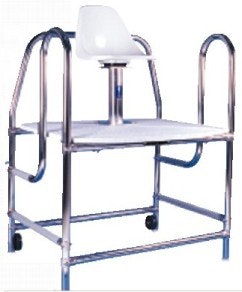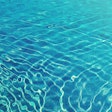The sheer amount of portable equipment needed to safely operate an indoor or outdoor pool can tax any aquatics director's accounting and storage methods

If you were to turn your natatorium over, Poseidon Adventure style, your patrons who managed to ride the waves onto the ceiling without getting electrocuted would find themselves dodging hundreds of items, large and small, that help owners operate their pools.
Aquatic facilities simply depend on more portable or semi-portable equipment than most other athletic or recreation center spaces. From products that test and maintain the body of water itself to those used to protect swimmers and extend the aquatics program's offerings, there is an awful lot for pool operators to purchase, track, maintain, replace and store. The sheer bulk and variety of necessary equipment is the reason your storage rooms frequently overflow; it's why your pool deck sometimes resembles a storage room and why your office might look something like this.
The specification of many of these items has a tendency to be given short shrift in the building process, considering that loose equipment represents well less than 1 percent of a pool's construction or renovation cost. Indeed, even in the day-to-day operation of an indoor or outdoor pool, it is easy for minor equipment needs to be ignored until things break or get lost in the shuffle. Conducting a regular inventory of the pool deck, storage room and (yes) pool office is a logical first step in making sure your pools and programs are properly stocked.
Maintenance Equipment
First off, you've got to make sure the pool water, and the deck surrounding it, is clean. Traditional vacuuming systems utilize the pool's circulation system and consist of an extension handle, a hose and a vacuum cleaner head, but good luck choosing just one of the latter. The dizzying array available includes flexible models of varying lengths, models equipped with swivel wheels, models specially designed for fiberglass-lined pools or spas, and tow models meant to be used by two people on opposite ends of a pool. More technologically advanced are automatic robotic cleaners, guided by a microprocessor, that are made by a number of manufacturers.
Need a brush for scrubbing the sides of the pool prior to vacuuming. Wall brushes come in straight-end, curved-end and dual-surface varieties. A vane flap can be added, the purpose of which is to create downward pressure when the pool bottom is brushed. Other brush types include angled and straight corner brushes, and stiffer-bristled algae brushes. One accessory of note: a contraption that holds a chlorine tab or container of muriatic acid at the end of a cleaning pole for scrubbing away dark algae or rust stains.
Outdoor pool owners especially will need to invest in a rake and a skimmer - or maybe more than one, since their size and durability vary. For excessive amounts of debris, one can always choose an extra-large, walk-behind skimmer. Those whose pool decks collect standing water will also need a squeegee or water broom.
All of these items will need to be stored somewhere. Hose reels can keep vacuum hoses in check, while poles and attachments can be hung on a range of hooks and hangers made specifically for these items. One type of hook is made especially for use on chain-link fences.
Though chemicals reside in auxiliary rooms sometimes far removed from the pool deck, test kits for monitoring pool water (chlorine, bromine and pH levels, and more) receive frequent use and so must be kept close by. So should other similar gadgets - pocket testers, portable meters and the like.
Covering a pool will help keep debris out of the water, minimize evaporation of water and chemicals, and save energy by reducing heating costs. (For these reasons, operators of indoor facilities that have one or more spas should invest in spa covers, as well.) Pool blankets, either of the solid insulated or solar bubble variety, lie directly on the surface of the water and are typically stored using an aluminum storage reel system. Safety covers, of the variety used during the winter months to cover an outdoor pool, are made of a vinyl-coated polyester fabric or a polypropylene mesh material, held on with anchored grommets. Since safety covers go unused for months at a time, these can be stored on a reel or folded. A so-called "liquid pool cover" (a chemical poured onto the surface of the water) can be used alone or in conjunction with a pool cover to further hinder the losses that come with evaporation.
Assisted Access
Providing people with disabilities access to your pool is not an option - it's the law. What is optional is the manner in which you get them there - and it pays both to ask an accessibility consultant for help and to survey your disabled users to find out their preference. The current accepted wisdom is that people with disabilities will prefer a method that allows them to enter the pool without assistance, but Randy Mendioroz, president of Carlsbad, Calif.-based Aquatic Design Group, says the reality is that this can be difficult to achieve.
"Everybody assumes that a wet ramp is the ultimate method," he says, "but here's what happens. Disabled patrons are not going to drive their good chair that's battery operated into the water. So they've got to transfer from their chair to a wet chair - which you provide and must bring to them - and somebody has to wait for the person to get in the water before retrieving the chair, since you can't leave it in the water for someone to bump into. Then the person swimming has to give the high sign to somebody to bring them back the wet chair. A wet ramp really is not in the spirit of ADA."
Since some states require that two different means of access are provided, a ramp (wet or dry) is often one of the two methods selected. (The choice of a ramp sometimes dictates the pool's configuration, with an offset area for therapeutic use a popular method of dealing with wheelchair parking and other space issues.)
As for the second means of access, a self-directed lift is by far the most compact and inexpensive choice. Lifts are battery- or water-powered, or manually operated - some are anchored to the pool deck, while others can be rolled from pool to pool - and use a number of methods to transfer a disabled individual from wheelchair to pool. Movable wheelchair lifts, transfer tiers and therapy ladders are other possibilities that allow people with disabilities or elderly individuals to lower themselves into the water.
Safety and Rescue Equipment
Much of the safety signage common in pool areas is incorporated into deck tile or hung on walls, but to really get the point across, standing signs that users must pass on their way to the pool can be worthwhile. These typically warn of wet deck conditions, lane closures or pool closures (used in conjunction with stanchions outfitted with plastic chains), or admonish swimmers not to run or dive. Lifeguards can carry whistles or megaphones to further warn patrons against unsafe behavior.
Should an accident occur, lifeguards have at their disposal a number of pieces of equipment that aid in the care of injured patrons. Swimmers in trouble can be fished out of the water with a shepherd's crook, throw rope or throw bag, or by a lifeguard equipped with a rescue tube or other flotation device. (Most pools, particularly outdoor water parks, stock personal flotation devices for patrons, usually children, who will use a pool in spite of being non-swimmers.) Handling of incapacitated swimmers is more delicate in the HIV era, usually requiring the use of CPR and bloodborne pathogen kits, which include disposable latex gloves, antiseptic towelettes and resuscitation masks. A first responder on the scene of a near-drowning might also be called on to use a manual suction device, an emergency oxygen unit or an automatic external defibrillator. Swimmers suffering an injury to the head, neck or spine must also be handled delicately, with a head immobilizer, spineboard and straps being the key pieces of equipment and the minimum designated by the American Red Cross. (The Red Cross also recommends rescue tubes in good condition, first-aid supplies including personal protective equipment, and two permanent communications systems - one for calling 911 and one to communicate with staff members and patrons in the facility.)
Rescue tools don't just collect dust on a shelf until accidents happen - lifeguards' intensive training requires them to be comfortable with all aspects of emergency situations and equipment. Training aids for lifeguards include CPR prompts that take them (or any other first responder) through the proper steps for resuscitating a drowning victim, and mannequins in all sizes for practicing CPR on toddlers, children and adults.
Portable lifeguard chairs come in many different configurations. While the typical chair height is around 6 feet, units for guarding shallow-water children's pools have chairs that are more like 30 to 36 inches high. Other important differences include the size of deck upon which the seat rests (some accommodate one or more standing guards) and the location and number of entry points to the deck (for continuous guarding even during guard changes). Some chairs are equipped with non-skid feet on all four legs; others tip up on wheels to make them easier to move.
In addition to all of the above, outdoor pool operators should be aware of the danger of summertime lightning strikes and plan accordingly by purchasing a lightning detector or lightning prediction system.
Competitive/Recreational Equipment
Want to accommodate swim meets? Thinking of adding recreational sports programs? Much of the equipment that can make it happen will eat up a lot of space on the pool deck or in the storage room.
Competition pools require wave-quelling lane lines, which come in five different sizes and styles, a variety of lengths, and myriad colors. These can be kept in place for lap swimming, or they can be wound up onto a lane storage reel - the size of which will determine how many lane lines can fit on each spindle. (With lane lines weighing anywhere from 30 to 230 pounds, depending on the size of the disks and the length of the lanes, a strong and durable carrier is a necessity.)
Certain competitive pool features, such as starting platforms and backstroke flags, must be installed or retrofitted permanently. Others, such as starting platform covers (to keep recreational users off platforms), portable bleachers or portable scoreboards (if selected over permanent units), must be stored if purchased. Lap counters, pace clocks, starting systems, starter's pistols or coaching paraphernalia (stopwatches, megaphones or whistles) all need to be locked away when not in use - and naturally, the storage bin options are almost as limitless as the equipment options.
Beyond having a pool with the proper water depth, establishing a water polo program requires an investment in balls (and a ball bag or carrier), goals, caps with ear guards, course markers and a portable scoring device. Training items include an accuracy trainer that fits into a standard goal (players shoot for the five cutouts), and a rebounder that allows players to hone their passing and shooting skills.
Water polo can also be played recreationally, and for these applications goals are available in a less finished (and less expensive) form. Similarly, water basketball standards and volleyball net systems allow recreational play in pools. Portable standards for basketball utilize a large base that when filled with water keeps them upright, while volleyball posts must be anchored in the pool deck.
Outdoor recreational items (leisure pool elements) are largely permanent structures, but one category of accessory that is sometimes overlooked in the planning stages is flotation toys. Whether shaped as single or double inner tubes, animals, bowls or rafts, inflatables must (like water polo balls) be inflated (using a hand or foot pump, or an air compressor) and stored when not in use. Foam toys are more easily handled and stored, whether by stacking (mats) or in carts made specifically for them (noodles).
Exercise Equipment
Cashing in on the aquatic exercise craze requires a bit of cash to transform the pool environment into a multifaceted fitness center. For those really serious about it, underwater treadmills and stationary bikes are a weighty (75 pounds and 50 pounds, respectively) alternative. Another aerobic choice is water exercise steps, which vary little from their land-based counterparts.
Underwater resistance exercise is aided by water's natural resistance, of course - and to heighten the effect, there are scores of pieces of equipment that can be used for thousands of different exercises. Flotation rings, buoyant cuffs and buoyant belts have a dual purpose: to help suspend an exerciser in deep water and to provide added resistance for arm and leg exercises, and for core stabilization. (A 5-foot tether can be used in conjunction with buoyant belts to allow exercisers to walk or jog in place.) Buoyant dumbbells and longer barbells with "weights" of closed-cell foam can be used in a fashion similar to land-based types, except that all strength work with these incorporates negative training. Fillable barbells can be used empty for negative training or, when filled with water, proprioceptive work. Actual weights do have uses in a water environment: Swim weights, for example, can be wrapped around wrists or ankles to help competitive swimmers the way land-based runners use weights when training. Weight belts, which are made of steel and covered in vinyl, help swimmers build strength and endurance.
Resistance bands and tubing have as many in-water as land-based uses, and possibly more. Bands clipped to racing lane lines from a swimmer's belt can allow him or her to swim in place; a 20-foot length of latex tubing hooked on a belt (usually with a small parachute hooked to the end) can create enough drag to intensify a swimmer's workout.
When stocking a pool full of fitness accessories, the usefulness of the good old-fashioned kickboard shouldn't be overlooked. As always, these have applications in swim training and in recreational programs.
To aid in instruction, particularly when the students are young and intimidated by water depth, stainless steel teaching platforms are available with or without adjustable legs.
Miscellaneous Facility Equipment
Chairs, tables (picnic or otherwise), large umbrellas and so forth are typically part of a facility's FF&E (furniture, fixtures and equipment) budget. But with all the options available, and deck space at a premium, some time should be spent selecting the number and style of units that will grace your pool area. Sources will include pool equipment suppliers, but also casual furniture suppliers and, for outdoor deck areas, general outdoor recreation suppliers.
This latter group will also be a source for specialty items such as trash bins, cigarette butt bins and (in the absence of umbrellas) portable shelters.
Much has been made in this article of storage issues, and it's nice to know that a number of specialty storage containers exist that are meant to be kept out in the open.
In our effort to provide this accounting of the most common (and some uncommon) portable products for pools, we relied heavily on information and illustrations provided by some of the pool industry's most established suppliers. (Information on these and other manufacturers and suppliers is available at athleticbusiness.com.) While those in the process of a major pool building or renovation project would be likely to leave the bulk of the product specifying to their design firm or aquatics consultant, pool equipment suppliers remain, for current pool operators, their primary source of information.
"It has been our experience that pool operators who rely on the catalog vendors are well served by them," says Aquatic Design Group's Mendioroz. "There are a lot of choices out there, but if you call the major pool equipment suppliers' toll-free numbers, most of their staffs are really knowledgeable and helpful."




































